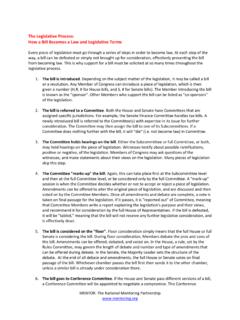Transcription of New Mexico Legislative Process - NM Arts
1 ADVOCACY 101 What is Advocacy? Webster s defines advocacy as the act of speaking, writing, or acting in support of something or someone. It is articulating your views on proposed laws, regulations, and policies that affect you, your family, and community. Advocacy is best accomplished by having many people voice their concerns Public Advocacy Public advocacy is educating the general public about an issue so that they will better understand and sympathize with your cause. Every time you speak to a group of individuals about your organization or issue concerning the value of the arts in society, you are doing public advocacy. Every time you write a letter to the editor or send an article to the newspaper, you are doing public advocacy.
2 Legislative Advocacy This is what most people think of when they hear the word advocacy. Legislative advocacy is working to influence legislation on a local, state, or national level. This includes legislation to provide additional funding or to create or improve outreach services. Doing Legislative advocacy is not difficult. Every time you write, call, or meet with elected officials to inform them about your organization, you are doing Legislative advocacy. Advocacy Tips Be informed. Read Legislative /advocacy alerts carefully. Know both sides of an issue. Know when a bill is in committee, when the hearing will be held, and who the co-sponsors are. Start early. Pay attention to issues and proposals early in the Process .
3 Be concise. State your position simply and clearly because you will have a better chance of getting people to listen and respond. Be specific. Know what you want from your legislator to draft legislation, propose an amendment, or vote for a bill. Be honest. Don t exaggerate the facts. Every issue has two sides be honest about acknowledging the pros and cons of your issue. Give personal examples. This puts your issue in human terms. Speak from your heart give real examples of what your issue has meant to you personally. It is much more powerful than giving dry statistics. Practice. Explain your position to friends and family before meeting with a legislator or testifying before a committee. 1 Continue to communicate.
4 Keep others informed of your progress and meetings so that follow-up action can be planned. Be courteous. Always remember to thank legislators for their time and interest, even when they disagree with your position. Be firm and confident. You are expressing your belief about a particular issue. Be confident in your convictions. Do not make threats. Telling a legislator that you will not vote for him in the future if s/he does not do what you are asking will only alienate him and may have long standing consequences. Never argue with your legislator. If it becomes apparent that the person you are meeting with will not support your issue, stick to the facts and ask her to consider your point of view. The goal here is to keep communication open and productive.
5 Do not give up. Just because your particular legislator may not be supportive, others working with you may have more success. Advocacy is an educational Process and takes time. New Mexico Legislative Process : Passage of a Bill Introduction & Committee Referral Legislators may singly or by committee introduce bills in either the senate or the House of Representatives. After a bill has been drafted and prepared for introduction, the Chief Clerk assigns it a number. The Reading Clerk reads it twice by number and title, along with the name of the principal sponsor. The presiding officer orders it printed and assigns it to one or more appropriate committees for further study. Committee Consideration & Action Most of the consideration of legislation in New Mexico occurs in committees.
6 It is in committees that the public has the opportunity to testify in favor or opposition to a particular bill. After considering the testimony, the committee can take one of several actions. 1. The committee may recommend to the Legislative body that a bill Do Pass, Do Pass as Amended, or Do Not Pass, or it may refer a bill back to the floor or to another committee Without Recommendation; 2. The committee may substitute a new and similar bill for the original bill, incorporating changes the committee may wish to make; 3. The committee may recommend referral of the bill to another committee; or 4. The committee may simply do nothing and let the bill die by not reporting it out of committee. 2 The committee reports are subject to adoption by the full House or senate .
7 When the favorable committee report is adopted, the bill is placed on the calendar, which is the schedule of business the House or senate must consider on any day. Final Passage When a bill is called for its third reading, members may debate its pros and cons on the chamber floor. Amendments may be added at this stage, or the entire bill may be substituted by another similar bill. The sponsor of the bill is allowed to close a debate by speaking last on the bill. A final vote is taken and recorded. Sent to the Other House After a bill receives a favorable vote, it is sent with a letter of transmittal to the other house where it follows a similar procedure. Duplication of procedure serves as a safety check ensuring that all aspects are considered before the bill is enacted into law.
8 Concurrence A bill that is amended in the second house must be sent back to the first house for agreement. This is called concurrence. If concurrence is denied, the second house votes on whether to recede or withdraw from its amendment. If it fails to recede, the bill is usually sent to a conference committee to attempt to work out a version agreeable to both houses. In order for the bill to pass, both houses must agree to the report of the conference committee. Enrolling & Engrossing When both houses in the legislature have agreed on a final version of the bill, it is enrolled & engrossed, which means that it is copied with all of its amendments or changes. The presiding officers of both houses sign the bill, and it is sent to the governor for his signature.
9 Governor s Action The governor may sign the bill, in which case it becomes a law of New Mexico , or 1. The governor may veto the bill, which means that he disapproves of it. If the legislature is still in session, it may attempt to override the governor s veto. 2. If the governor fails to sign the bill within three days while the legislature is still in session, it becomes law without his signature. 3. If the legislature has adjourned, the governor has 20 days from adjournment to decide about bills the legislature has sent. If the governor fails to act upon a bill after the legislature has adjourned, it is called a pocket veto. 4. The governor of New Mexico may also line item veto specifics in bills sent to him.
10 3 Laws Not all laws go into effect at the same time. Some bills carry an emergency clause and become effective as soon as the governor signs them. All other bills, except bills that carry a later effective date, become effective 90 days after the legislature adjourns. New Mexico Legislature: An Overview The New Mexico Legislature has two chambers. Chamber Membership Length of Term Time of Election House of Representatives 70 2 years All seats elected at every general election senate 42 4 years All seats elected at every other general election Each year the New Mexico Legislature convenes at noon on the third Tuesday in January. The length of a regular Legislative session alternates between 60 days in odd numbered years and 30 days in even numbered years.




